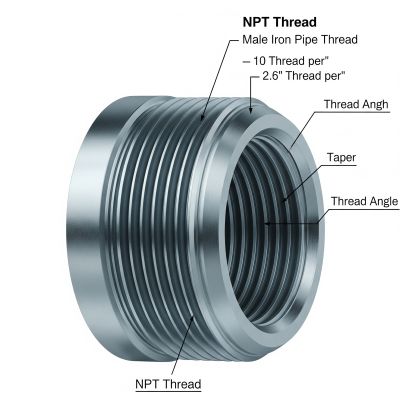Understanding thread compatibility is crucial in plumbing and mechanical work. Even small mistakes can lead to leaks, cross-threading, damaged parts, and wasted materials — all of which mean extra time, expense, and frustration.
This article is here to clear up one of the most common sources of confusion: Are NPT and MIP fittings compatible? We’ll go over the fundamentals, teach you how to steer clear of typical problems, and make sure your next project runs well.
What Are NPT and MIP Threads?
Before diving into compatibility, it’s important to understand what NPT and MIP threads are.
NPT (National Pipe Tapered) is a widely recognized standard for pipe threads in North America. Because the threads are tapered, they get thinner as they pass through the fitting. The threads can compress tightly together thanks to this taper design, producing a pressure-resistant seal that is perfect for fluid and gas applications.
A male fitting that adheres to NPT specifications is called MIP (Male Iron Pipe). Even though they are called “Iron Pipe,” modern MIP fittings can be composed of a number of materials, such as plastic, stainless steel, and brass. The term “Iron Pipe” is historical and simply points to the original context in which the thread type was widely used.
How Are NPT and MIP Threads Designed?
Both NPT and MIP threads share a tapered thread design, which is key to how they seal. As you screw two fittings together, the threads compress against each other, forming a tight, leak-resistant joint.
Thread Angle and Pitch are also standardized:
➡️ NPT threads have a 60° thread angle.
➡️ Both NPT and MIP fittings match up in thread pitch and size, meaning the distance between each thread is consistent across these standards when appropriately sized.
This uniformity is what makes NPT and MIP fittings generally compatible.
Are NPT and MIP Fittings Compatible?
In general, NPT and MIP fittings are compatible, so the answer is yes.
Male fittings with NPT thread requirements are basically what MIP fittings are. This means:
1. An NPT female fitting will be connected to a male MIP fitting.
2. A FIP fitting (Female Iron Pipe) will accept an NPT male fitting.
As long as the thread sizes match (such as ½”, ¾”, etc.), the parts should fit together without any special adaptors.
Common Mistakes to Avoid
While MIP and NPT are compatible, a few common mistakes can cause big problems:
Mixing Thread Standards
Example: Attempting to connect an NPT fitting to a BSP (British Standard Pipe) fitting.
Problem: Although they may look similar, they are different in pitch, angle, and sealing method, resulting in leaks or damage.
Cross-Threading
1. Always start fittings by hand to ensure they thread smoothly.
2. Forcing threads misaligned can damage both components.
Over-Tightening
1. Over-tightening can crack fittings, especially in plastic or brass.
2. It can also deform the threads, preventing a proper seal.
Skipping Sealants
1. Tapered threads like NPT/MIP require PTFE thread tape (commonly called Teflon tape) or thread compound to properly seal.
2. No sealant = high risk of leaks.
How to Properly Connect NPT and MIP Fittings
Here’s a quick step-by-step to ensure a leak-free connection:
Step-by-Step Guide
1. Clean the threads to remove debris or manufacturing oil.
2. Wrap PTFE thread tape around the male threads (2-3 wraps clockwise).
3. Hand-tighten the male fitting into the female fitting.
4. Snug with a wrench, but avoid over-tightening. A firm grip is enough.
Signs of a Proper Connection
1. Threads engage smoothly without excessive resistance.
2. No visible gaps between the fittings.
3. No leaks during pressure testing.
What About Other Similar Terms?
Some related terms you might see when shopping for fittings:
FIP (Female Iron Pipe)
➡️ The female counterpart to MIP.
➡️ Designed to accept MIP (or NPT) male threads.
NPS (National Pipe Straight)
➡️ Unlike NPT, NPS threads are straight, not tapered.
➡️ When a gasket, rather than the threads themselves, is used to create the seal, this is used.
Decoding Fitting Labels
➡️ MIP = Male fitting with tapered (NPT) threads.
➡️ FIP = Female fitting with tapered (NPT) threads.
➡️ NPT = Tapered threads, standard in North America.
➡️ NPS = Straight threads, requires a gasket for sealing.
Understanding these terms helps avoid confusion when purchasing or assembling fittings.
Practical Applications and Examples
You’ll find MIP and NPT fittings used in many everyday and industrial applications, such as:
➡️ Water supply lines for sinks, toilets, and appliances.
➡️ Gas piping for residential and commercial systems.
➡️ Air compressor systems for workshops and manufacturing.
➡️ Irrigation and outdoor plumbing setups.
Example:
You can safely connect a brass MIP fitting to an iron NPT coupling — provided the size matches and proper thread sealing techniques are used.
Conclusion
In summary:
➡️ MIP and NPT fittings are compatible when properly matched by size.
➡️ Both use a tapered thread that forms a strong, pressure-resistant seal when tightened.
➡️ Always use thread sealants like PTFE tape to prevent leaks.
➡️ Be cautious about mixing thread types (like BSP or NPS) and avoid over-tightening to protect the fittings.
Always double-check the labels and thread specifications when selecting fittings. Much more annoyance can be avoided later with a little more caution up front!
Post time: May-29-2025


